Investigation of the Magnetosphere of Ganymede with Galileo's Energetic Particle Detector
Ph.D. dissertation by Shawn M. Stone, University of Kansas,
1999.
Copyright 1999 by Shawn M. Stone. Used with permission.
4.4 The O6 Multipole Model of the Jovian Internal Field
The O6 model is a multipole model of order nmax=3. The data used to fit the gnm and hnm in a least squares fashion are based on the observations of Pioneer 11 and Voyager 1. This model was derived under the assumption that the magnetic field has not changed appreciably between the Pioneer 11 encounter in 1973 and that of Voyager 1 in 1979 [Connerney, 1993]. Table 4.4 lists the Schmidt coefficients of the O6 model in JSIII(1965). Figure 4.8 dispays the meridian plane projection of the O6 model in JSIII(1965) compared to the dipole model. The O6 model benefits from a better spatial coverage of the Jovian magnetosphere from the wide coverage between the Pioneer 11 and Voyager 1 encounters. The coefficients are then more tightly constrained.
Table 4.4 The Jupiter O6 magnetic field model Schmidt-Normalized spherical harmonic coefficients in Gauss as given by Connerney [1993]. The coefficients are cast in Jupiter System III(1965).
| n | m | gnm | hnm |
| 1 | 0 | 4.24202 | --- |
| 1 | 1 | -.65929 | .24116 |
| 2 | 0 | -.02181 | --- |
| 2 | 1 | -.71106 | -.40304 |
| 2 | 2 | .48714 | .07179 |
| 3 | 0 | .07565 | --- |
| 3 | 1 | -.15493 | -.38824 |
| 3 | 2 | .19775 | .34243 |
| 3 | 3 | -.17958 | -.22439 |
Figure 4.8 The O6 model multipole field [Connerney, 1993] compared to the dipole model in JSIII(1965) coordinates.

4.5 The Magnetodisk Current Sheet: Vector Potential Model
The magnetodisk of Jupiter extends from 5<=R<=50 Rj and is about 5 Rj thick centered on the JSMIII equatorial axis [Connerney et al., 1981]. Its effect on the Jovian magnetic field is plainly seen in the ΔB plots shown in Figure 4.9. This plot shows the difference of each component between the observed magnetic field of Voyager 1 for the outbound pass [Ness et al., 1979] and the O4 model [Acuna and Ness, 1976]. From examining this figure it is easy to see that the field lines are distended radially outward by presence of the current sheet.
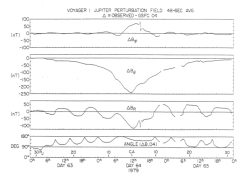 |
Figure 4.9 Perturbation magnetic field ΔB observed by Voyager 1 during passage through the Jovian magnetosphere for R<30 Rj from the GSFC O4 model [Acuna and Ness, 1976]. The bottom panel shows the angle between the perturbation field and the reference field [Connerney, 1981]. |
The magnetic field model of the current sheet in a cylindrical coordinate system
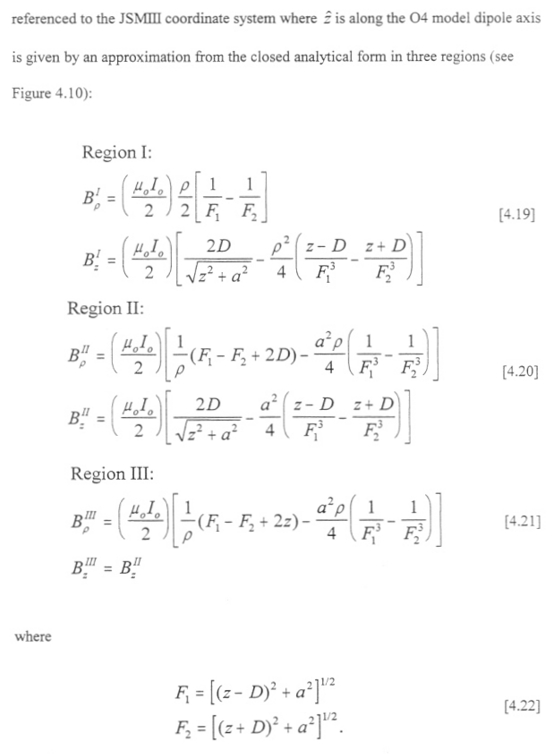
The parameter D is the full thickness and a is the half thickness of the sheet; ρ, z, a, and D are expressed in Jovian radii. A choice for the current of μ0I0 / 2 = 225(150), expressed in Gauss, results in computed components that fit the Voyager 1 (Voyager 2) data well [Connerney et al., 1981]. Figure 4.11 shows the magnetic field topology that results from this ring current model. The overall result is that the field lines are swept radially outwards beyond the dipole as shown in Figure 4.12 for the O4 plus sheet model.
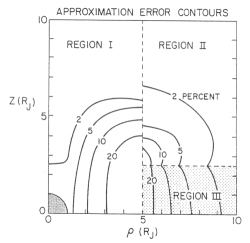 |
Figure 4.10 Contour map showing maximum errors in the current sheet model magnetic field components for Bρ and Bz for the simple analytic forms from the closed form models of the current sheet given in Equations 4.19 to 4.21 [Connerney, 1981]. |
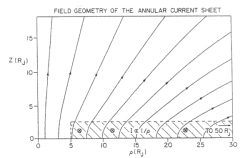 |
Figure 4.11 Meridian plane projection of the field lines associated with the ring current as modeled in Equations 4.19 through 4.21 [Connerney, 1981]. |
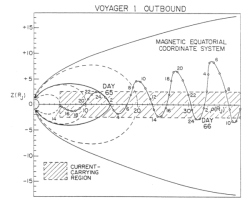 |
Figure 4.12 Meridian plane projection of the Voyager outbound pass in 1979. The location of the model of the azimuthal current sheet is shown in cross section [Connerney, 1981]. |
Next: 4.6 The Magnetodisc Current Sheet: Euler Potential Model
Return to dissertation table of contents page.
Return to main
Galileo Table of Contents Page.
Return to Fundamental
Technologies Home Page.
Updated 8/23/19, Cameron Crane
QUICK FACTS
Mission Duration: Galileo was planned to have a mission duration of around 8 years, but was kept in operation for 13 years, 11 months, and 3 days, until it was destroyed in a controlled impact with Jupiter on September 21, 2003.
Destination: Galileo's destination was Jupiter and its moons, which it orbitted for 7 years, 9 months, and 13 days.



